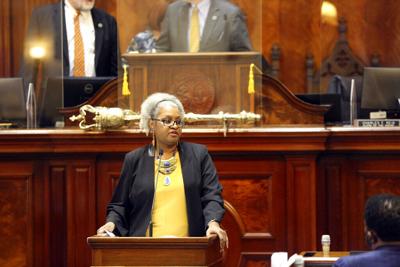COLUMBIA — A pending, post-census realignment of South Carolina’s legislative districts removes seats in both chambers for Richland County while expanding Lexington County’s political muscle in the Statehouse.
A lopsided increase of nearly 500,000 people in South Carolina since 2010 is pushing dramatic changes in who represents the Midlands, as legislators redraw districts to account for growth concentrated along the coast and the Charlotte suburbs.
“This is probably one of the hardest draws that I’ve come across in many years,” state demographer Will Roberts told a Senate panel Nov. 4. To balance the population shifts, he said, "We have to switch the geographic areas."
In South Carolina, legislators are in charge of drawing their own voting lines. The census update means each House seat should represent roughly 40,000 people, while each senator should represent about 110,000.
The House overwhelmingly approved its new maps Dec. 2. That plan will get a final floor vote Dec. 6, the same day the Senate takes up its proposed new lines.
Here’s a look at what the changes mean for Richland and Lexington counties.
Richland County
Although Richland's population has grown since 2010, it did so at a slower pace than even its neighboring county. To adjust, legislators merged two seats each in the House and Senate held by Columbia-area lawmakers.
The Senate map would put incumbent Democrats Dick Harpootlian of Columbia and Nikki Setzler of West Columbia in the same district. The merger moves Harpootlian's district — which currently stretches from downtown Columbia to Lake Murray and the Newberry County border — to Charleston County, where growth exploded.
Harpootlian said the new Senate map does a better job of keeping like-minded communities together, while ensuring Richland County holds on to at least three resident senators.
"I have no problem with what you’ve done to my district. As someone who’s had to represent people whose major interest is on Lake Murray as opposed to people whose major issue is what happens in Five Points, it’s almost schizophrenic,” he said during an Oct. 12 meeting of the Senate redistricting panel.
He approved of the changes to his district, initially proposed by the League of Women Voters, as beneficial to voters, "even if it means my political demise.”
Currently, five senators represent parts of Richland County. That would grow to six under the plan, with the lines for three senators' districts contained within Richland County's borders: Democrats Darrell Jackson, John Scott and Mia McLeod. The new map removes parts of conservative Kershaw County from McLeod's district, making it easier for a Democrat to keep that seat.
The House maps combine the districts of Democrats Wendy Brawley and Jermain Johnson, who both live in rural Hopkins. Richland County would be represented by 11 people in the House, instead of 12.
During the Dec. 2 floor debate, Brawley offered two amendments to change the lines. Both failed.
"We get it. We understand that Republicans hold the majority, but we don’t understand — or at least, it's difficult for me to get — for us to stand here and say this is fair, when the districts are so gerrymandered not only to protect incumbent Republicans but to increase their numbers so significantly that it totally marginalizes the Democratic vote,” she said.
"It is highly, highly gerrymandered ... to the disadvantage of most Democrats and minorities. It protects Republicans."
An analysis of the proposed House districts by the Princeton University’s Gerrymandering Project determined they would likely result in 83 Republicans elected — two more than the GOP’s current advantage and enough to give them a supermajority.
Florence Republican Jay Jordan, who chaired the House redistricting committee, said the map wasn’t designed to influence elections.
“Some things are just honestly out of our control. South Carolina grew tremendously in certain parts of the state. And in certain rural areas, we lost population. That's something we need to take into consideration,” he said.
Lexington County
Because of big growth in areas surrounding Lake Murray and its southern reaches, Lexington County will have now have 11 House members in its delegation, up from nine currently.
And a last-minute push by Pelion residents helped keep the small Lexington County town – home to the South Carolina Pelion Peanut Party – in the district of GOP Sen. Katrina Shealy.
Initially, the Senate’s proposed map put the 1,000-resident community into the district of Minority Leader Brad Hutto, D-Orangeburg, which would have ended decades of representation by senators who live in Lexington County. His already-large district will further expand to cover all or parts of seven counties, up from six.
Mayor Frank Shumpert said the retail politicking and relationship-building developed over years of familiarity with lawmakers would be lost if Hutto's district enveloped his town.
“I'm sure Mr. Hutto is an outstanding individual, but he would have bits and pieces or wholes of seven counties. Looking after seven counties is more than a yeoman's job, I don't know how that would actually be humanly possible,” he said during a Nov. 23 hearing. “Having a non-resident senator that lives miles and miles away, whether we can get their ear is a question that I don't know the answer to.”
Shumpert was among several residents who spoke against such a prospect.
Their opposition led to a shifting of the lines that put Pelion back with Shealy. Meanwhile, Hutto picked up a rural swath of southwest Lexington County, along the Aiken County border.
"I'm very attentive to their needs," Shealy told The Post and Courier Dec. 3. "All these areas are growing but over the next 10 years, this is our chance not to be overcome by a senator more interested in where they live."
The Senate's proposed map, to be debated on the floor next week, gives Lexington County an additional seat due to the reconfiguring of a rural district anchored in Greenwood County.
Seanna Adcox reported from Columbia.








